Abstract
Klebsiella pneumoniae, a worldwide cause of nosocomial infections, is one of the most common causes of death in newborns in nurseries. In this study, we investigated the role of interleukin-1 (IL-1) in an experimental animal model of neonatal sepsis, using a natural antagonist of IL-1 receptors, the IL-1 receptor antagonist (IL-1Ra), to block IL-1's effects in neonatal Klebsiella sepsis in the absence of antibiotic treatment. Newborn Wistar-Kyoto rats were injected intraperitoneally with a single dose (10 mg/kg) of either IL-1Ra (n = 43) or human serum albumin as a control (n = 40). At the same time, a 50% lethal dose of K. pneumoniae was injected subcutaneously. No antibiotics were given at any time. After 10 days, survival was 60% for the albumin group and 80% for the IL-1Ra group (P < 0.01). IL-1Ra treatment also afforded protection when the dose of bacteria was increased sixfold (P < 0.01). There were two episodes of leukopenia in the control group, which were suppressed by IL-1Ra (P < 0.01 and P < 0.001). IL-1 and IL-6 levels were lower in the IL-1Ra-treated group (P < 0.05 and P < 0.001, respectively). No differences between the two groups were observed in the number of bacteria in cultures of the blood, lungs, liver, or spleen. When IL-1Ra (10 mg/kg) was given both at time zero and 24 h after bacterial challenge, lethality was significantly increased (P < 0.01). Single doses of IL-1Ra of from 20 to 40 mg/kg progressively increased lethality compared with controls (P < 0.01) in both Wistar-Kyoto and Sprague-Dawley strain rats. In the same model, low doses of IL-1 itself (0.4 ng per rat), given 24 h prior to bacterial challenge, afforded protection (P < 0.001). These studies suggest that, in the absence of antibiotics, partial blockade of IL-1 receptors improves survival, whereas a longer or greater blockade increases lethality in newborn rats infected with K. pneumoniae.
Full text
PDF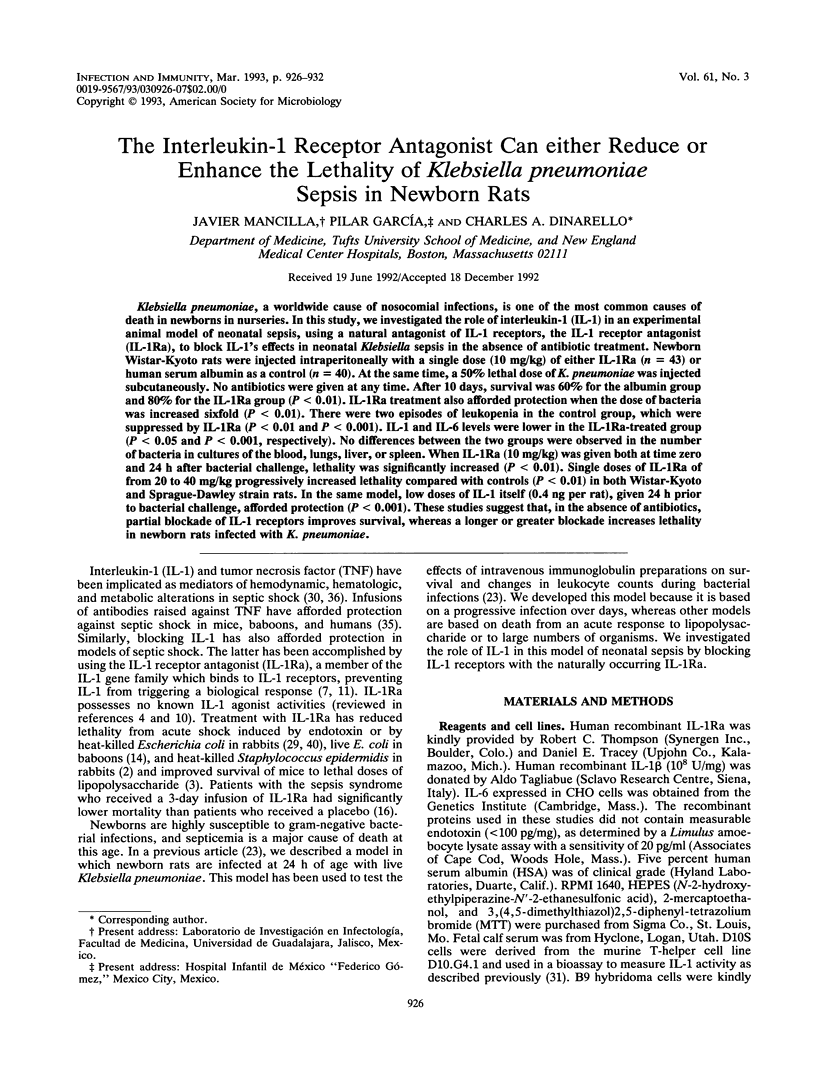
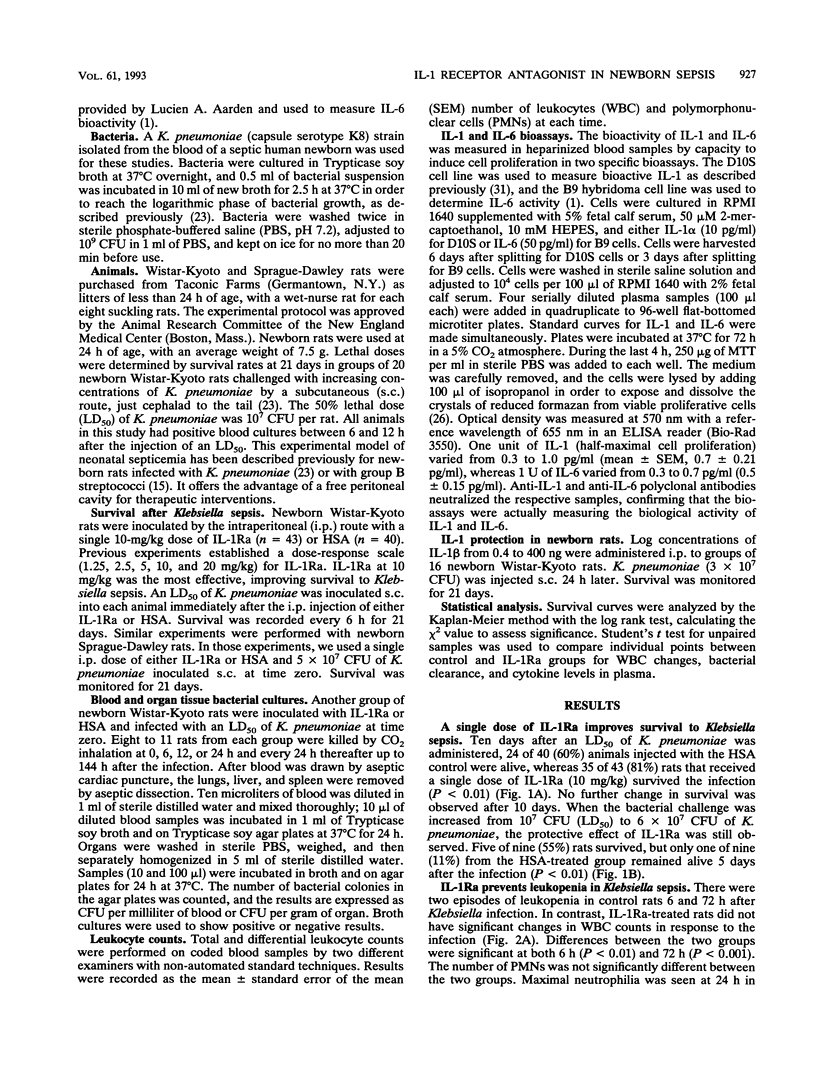
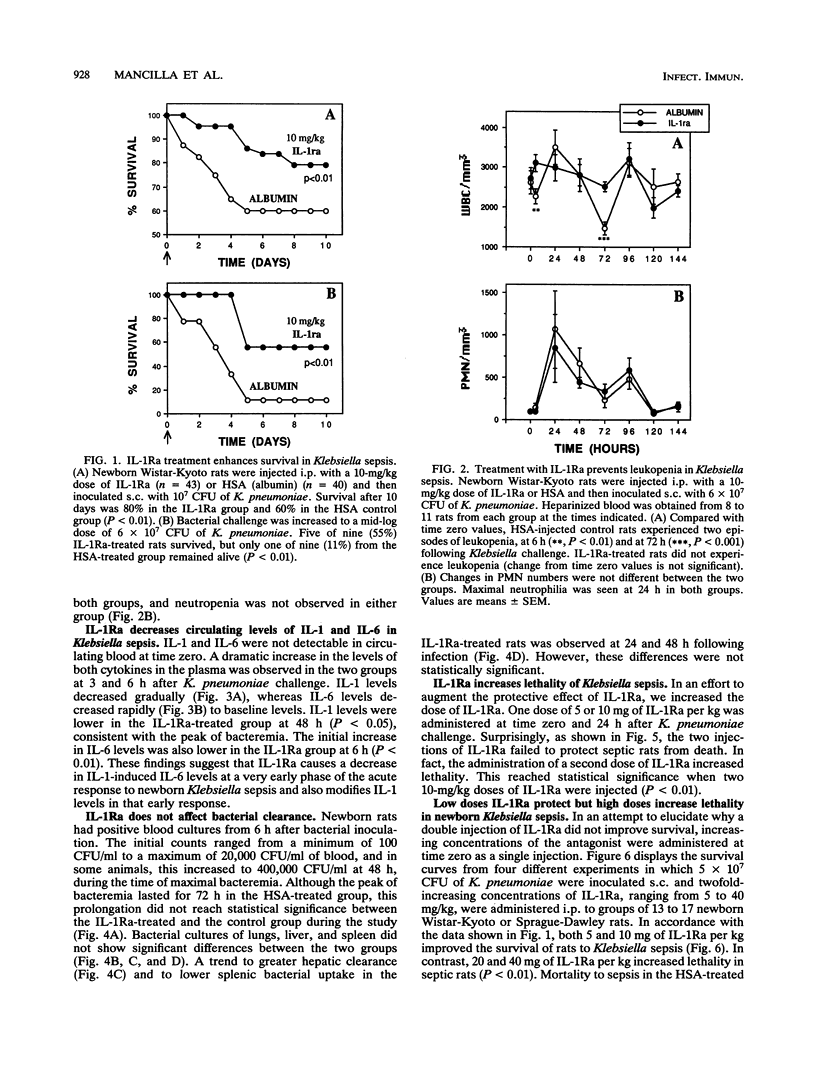
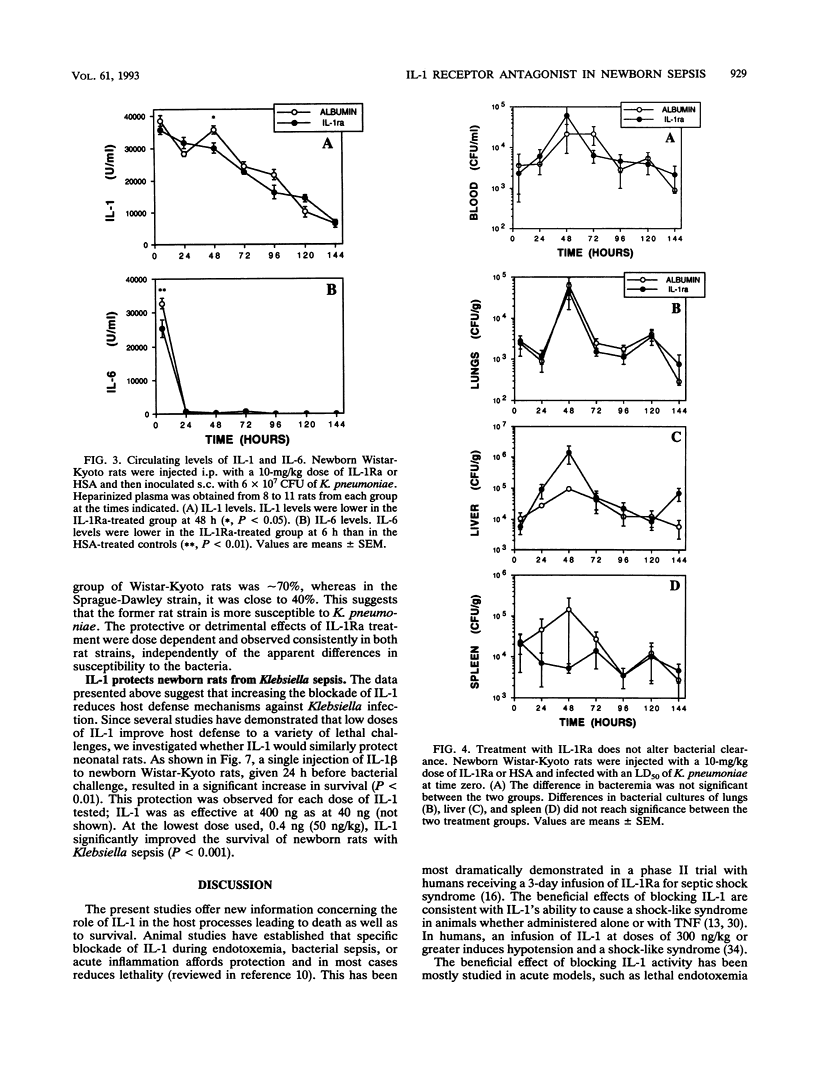
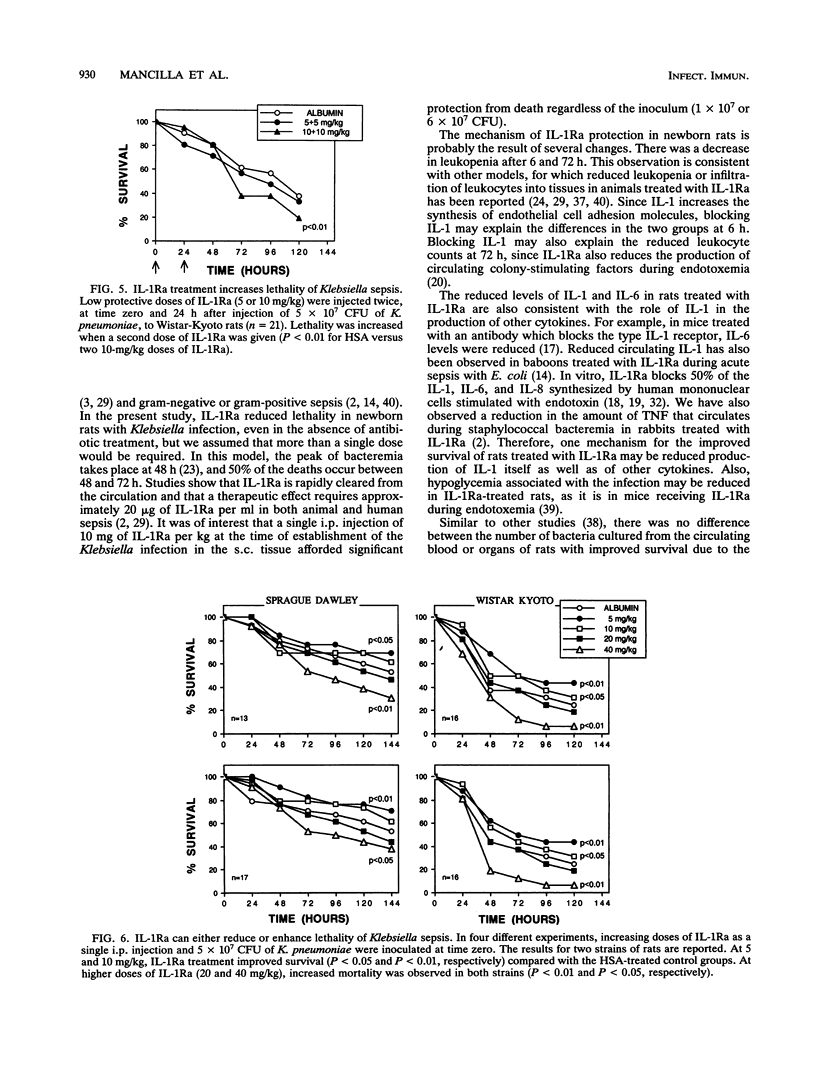
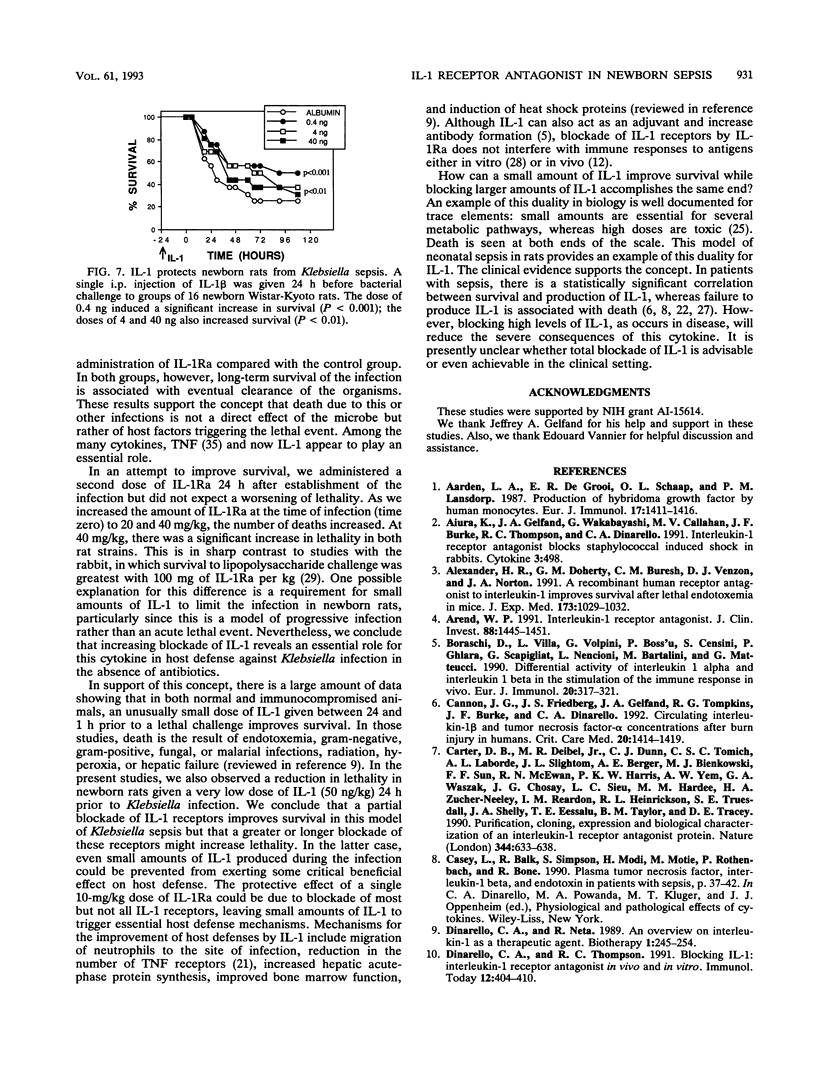
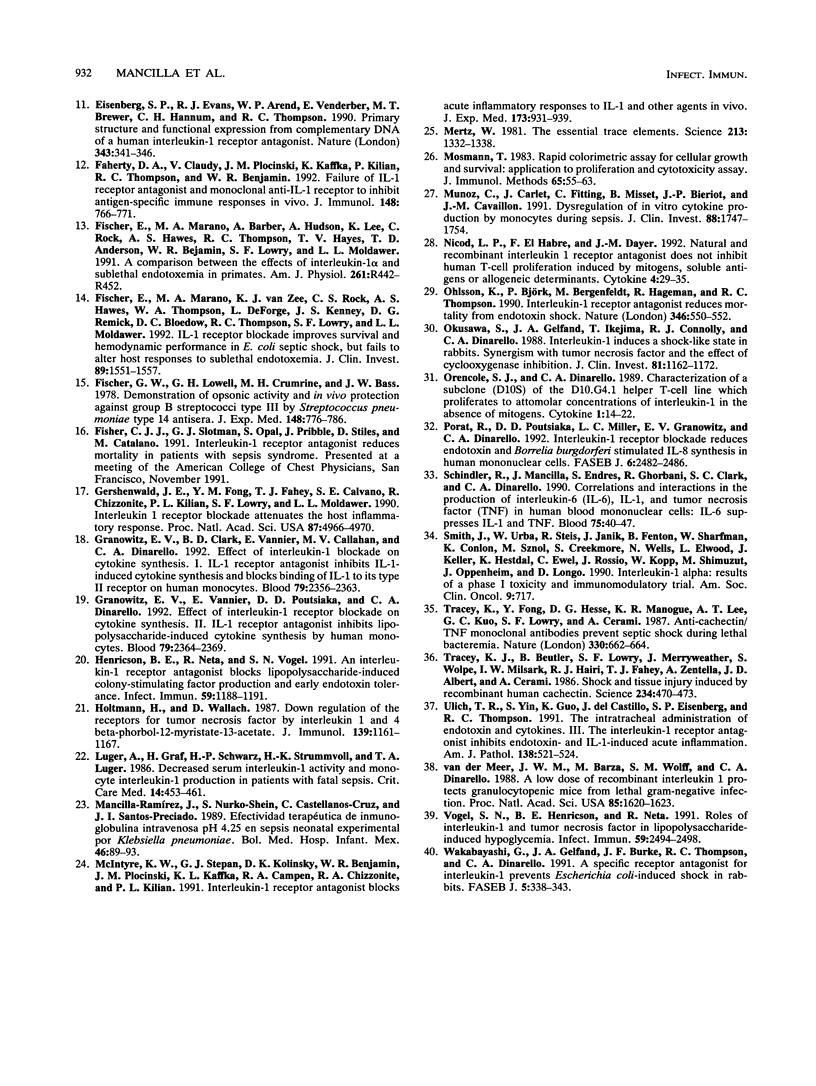
Selected References
These references are in PubMed. This may not be the complete list of references from this article.
- Aarden L. A., De Groot E. R., Schaap O. L., Lansdorp P. M. Production of hybridoma growth factor by human monocytes. Eur J Immunol. 1987 Oct;17(10):1411–1416. doi: 10.1002/eji.1830171004. [DOI] [PubMed] [Google Scholar]
- Alexander H. R., Doherty G. M., Buresh C. M., Venzon D. J., Norton J. A. A recombinant human receptor antagonist to interleukin 1 improves survival after lethal endotoxemia in mice. J Exp Med. 1991 Apr 1;173(4):1029–1032. doi: 10.1084/jem.173.4.1029. [DOI] [PMC free article] [PubMed] [Google Scholar]
- Arend W. P. Interleukin 1 receptor antagonist. A new member of the interleukin 1 family. J Clin Invest. 1991 Nov;88(5):1445–1451. doi: 10.1172/JCI115453. [DOI] [PMC free article] [PubMed] [Google Scholar]
- Boraschi D., Villa L., Volpini G., Bossù P., Censini S., Ghiara P., Scapigliat G., Nencioni L., Bartalini M., Matteucci G. Differential activity of interleukin 1 alpha and interleukin 1 beta in the stimulation of the immune response in vivo. Eur J Immunol. 1990 Feb;20(2):317–321. doi: 10.1002/eji.1830200213. [DOI] [PubMed] [Google Scholar]
- Cannon J. G., Friedberg J. S., Gelfand J. A., Tompkins R. G., Burke J. F., Dinarello C. A. Circulating interleukin-1 beta and tumor necrosis factor-alpha concentrations after burn injury in humans. Crit Care Med. 1992 Oct;20(10):1414–1419. doi: 10.1097/00003246-199210000-00009. [DOI] [PubMed] [Google Scholar]
- Carter D. B., Deibel M. R., Jr, Dunn C. J., Tomich C. S., Laborde A. L., Slightom J. L., Berger A. E., Bienkowski M. J., Sun F. F., McEwan R. N. Purification, cloning, expression and biological characterization of an interleukin-1 receptor antagonist protein. Nature. 1990 Apr 12;344(6267):633–638. doi: 10.1038/344633a0. [DOI] [PubMed] [Google Scholar]
- Dinarello C. A., Neta R. An overview on interleukin-1 as a therapeutic agent. Biotherapy. 1989;1(4):245–254. doi: 10.1007/BF02171000. [DOI] [PubMed] [Google Scholar]
- Dinarello C. A., Thompson R. C. Blocking IL-1: interleukin 1 receptor antagonist in vivo and in vitro. Immunol Today. 1991 Nov;12(11):404–410. doi: 10.1016/0167-5699(91)90142-G. [DOI] [PubMed] [Google Scholar]
- Eisenberg S. P., Evans R. J., Arend W. P., Verderber E., Brewer M. T., Hannum C. H., Thompson R. C. Primary structure and functional expression from complementary DNA of a human interleukin-1 receptor antagonist. Nature. 1990 Jan 25;343(6256):341–346. doi: 10.1038/343341a0. [DOI] [PubMed] [Google Scholar]
- Faherty D. A., Claudy V., Plocinski J. M., Kaffka K., Kilian P., Thompson R. C., Benjamin W. R. Failure of IL-1 receptor antagonist and monoclonal anti-IL-1 receptor antibody to inhibit antigen-specific immune responses in vivo. J Immunol. 1992 Feb 1;148(3):766–771. [PubMed] [Google Scholar]
- Fischer E., Marano M. A., Barber A. E., Hudson A., Lee K., Rock C. S., Hawes A. S., Thompson R. C., Hayes T. J., Anderson T. D. Comparison between effects of interleukin-1 alpha administration and sublethal endotoxemia in primates. Am J Physiol. 1991 Aug;261(2 Pt 2):R442–R452. doi: 10.1152/ajpregu.1991.261.2.R442. [DOI] [PubMed] [Google Scholar]
- Fischer E., Marano M. A., Van Zee K. J., Rock C. S., Hawes A. S., Thompson W. A., DeForge L., Kenney J. S., Remick D. G., Bloedow D. C. Interleukin-1 receptor blockade improves survival and hemodynamic performance in Escherichia coli septic shock, but fails to alter host responses to sublethal endotoxemia. J Clin Invest. 1992 May;89(5):1551–1557. doi: 10.1172/JCI115748. [DOI] [PMC free article] [PubMed] [Google Scholar]
- Fischer G. W., Lowell G. H., Crumrine M. H., Bass J. W. Demonstration of opsonic activity and in vivo protection against group B streptococci type III by Streptococcus pneumoniae type 14 antisera. J Exp Med. 1978 Sep 1;148(3):776–786. doi: 10.1084/jem.148.3.776. [DOI] [PMC free article] [PubMed] [Google Scholar]
- Gershenwald J. E., Fong Y. M., Fahey T. J., 3rd, Calvano S. E., Chizzonite R., Kilian P. L., Lowry S. F., Moldawer L. L. Interleukin 1 receptor blockade attenuates the host inflammatory response. Proc Natl Acad Sci U S A. 1990 Jul;87(13):4966–4970. doi: 10.1073/pnas.87.13.4966. [DOI] [PMC free article] [PubMed] [Google Scholar]
- Granowitz E. V., Clark B. D., Vannier E., Callahan M. V., Dinarello C. A. Effect of interleukin-1 (IL-1) blockade on cytokine synthesis: I. IL-1 receptor antagonist inhibits IL-1-induced cytokine synthesis and blocks the binding of IL-1 to its type II receptor on human monocytes. Blood. 1992 May 1;79(9):2356–2363. [PubMed] [Google Scholar]
- Granowitz E. V., Vannier E., Poutsiaka D. D., Dinarello C. A. Effect of interleukin-1 (IL-1) blockade on cytokine synthesis: II. IL-1 receptor antagonist inhibits lipopolysaccharide-induced cytokine synthesis by human monocytes. Blood. 1992 May 1;79(9):2364–2369. [PubMed] [Google Scholar]
- Henricson B. E., Neta R., Vogel S. N. An interleukin-1 receptor antagonist blocks lipopolysaccharide-induced colony-stimulating factor production and early endotoxin tolerance. Infect Immun. 1991 Mar;59(3):1188–1191. doi: 10.1128/iai.59.3.1188-1191.1991. [DOI] [PMC free article] [PubMed] [Google Scholar]
- Holtmann H., Wallach D. Down regulation of the receptors for tumor necrosis factor by interleukin 1 and 4 beta-phorbol-12-myristate-13-acetate. J Immunol. 1987 Aug 15;139(4):1161–1167. [PubMed] [Google Scholar]
- Luger A., Graf H., Schwarz H. P., Stummvoll H. K., Luger T. A. Decreased serum interleukin 1 activity and monocyte interleukin 1 production in patients with fatal sepsis. Crit Care Med. 1986 May;14(5):458–461. doi: 10.1097/00003246-198605000-00004. [DOI] [PubMed] [Google Scholar]
- Mancilla-Ramírez J., Nurko-Shein S., Castellanos-Cruz C., Santos-Preciado J. I. Efectividad terapéutica de inmunoglobulina intravenosa pH 4.25 en sepsis neonatal experimental por Klebsiella pneumoniae. Bol Med Hosp Infant Mex. 1989 Feb;46(2):89–93. [PubMed] [Google Scholar]
- McIntyre K. W., Stepan G. J., Kolinsky K. D., Benjamin W. R., Plocinski J. M., Kaffka K. L., Campen C. A., Chizzonite R. A., Kilian P. L. Inhibition of interleukin 1 (IL-1) binding and bioactivity in vitro and modulation of acute inflammation in vivo by IL-1 receptor antagonist and anti-IL-1 receptor monoclonal antibody. J Exp Med. 1991 Apr 1;173(4):931–939. doi: 10.1084/jem.173.4.931. [DOI] [PMC free article] [PubMed] [Google Scholar]
- Mertz W. The essential trace elements. Science. 1981 Sep 18;213(4514):1332–1338. doi: 10.1126/science.7022654. [DOI] [PubMed] [Google Scholar]
- Mosmann T. Rapid colorimetric assay for cellular growth and survival: application to proliferation and cytotoxicity assays. J Immunol Methods. 1983 Dec 16;65(1-2):55–63. doi: 10.1016/0022-1759(83)90303-4. [DOI] [PubMed] [Google Scholar]
- Munoz C., Carlet J., Fitting C., Misset B., Blériot J. P., Cavaillon J. M. Dysregulation of in vitro cytokine production by monocytes during sepsis. J Clin Invest. 1991 Nov;88(5):1747–1754. doi: 10.1172/JCI115493. [DOI] [PMC free article] [PubMed] [Google Scholar]
- Nicod L. P., el Habre F., Dayer J. M. Natural and recombinant interleukin 1 receptor antagonist does not inhibit human T-cell proliferation induced by mitogens, soluble antigens or allogeneic determinants. Cytokine. 1992 Jan;4(1):29–35. doi: 10.1016/1043-4666(92)90033-n. [DOI] [PubMed] [Google Scholar]
- Ohlsson K., Björk P., Bergenfeldt M., Hageman R., Thompson R. C. Interleukin-1 receptor antagonist reduces mortality from endotoxin shock. Nature. 1990 Dec 6;348(6301):550–552. doi: 10.1038/348550a0. [DOI] [PubMed] [Google Scholar]
- Okusawa S., Gelfand J. A., Ikejima T., Connolly R. J., Dinarello C. A. Interleukin 1 induces a shock-like state in rabbits. Synergism with tumor necrosis factor and the effect of cyclooxygenase inhibition. J Clin Invest. 1988 Apr;81(4):1162–1172. doi: 10.1172/JCI113431. [DOI] [PMC free article] [PubMed] [Google Scholar]
- Orencole S. F., Dinarello C. A. Characterization of a subclone (D10S) of the D10.G4.1 helper T-cell line which proliferates to attomolar concentrations of interleukin-1 in the absence of mitogens. Cytokine. 1989 Nov;1(1):14–22. doi: 10.1016/1043-4666(89)91044-2. [DOI] [PubMed] [Google Scholar]
- Porat R., Poutsiaka D. D., Miller L. C., Granowitz E. V., Dinarello C. A. Interleukin-1 (IL-1) receptor blockade reduces endotoxin and Borrelia burgdorferi-stimulated IL-8 synthesis in human mononuclear cells. FASEB J. 1992 Apr;6(7):2482–2486. doi: 10.1096/fasebj.6.7.1532945. [DOI] [PubMed] [Google Scholar]
- Schindler R., Mancilla J., Endres S., Ghorbani R., Clark S. C., Dinarello C. A. Correlations and interactions in the production of interleukin-6 (IL-6), IL-1, and tumor necrosis factor (TNF) in human blood mononuclear cells: IL-6 suppresses IL-1 and TNF. Blood. 1990 Jan 1;75(1):40–47. [PubMed] [Google Scholar]
- Tracey K. J., Beutler B., Lowry S. F., Merryweather J., Wolpe S., Milsark I. W., Hariri R. J., Fahey T. J., 3rd, Zentella A., Albert J. D. Shock and tissue injury induced by recombinant human cachectin. Science. 1986 Oct 24;234(4775):470–474. doi: 10.1126/science.3764421. [DOI] [PubMed] [Google Scholar]
- Tracey K. J., Fong Y., Hesse D. G., Manogue K. R., Lee A. T., Kuo G. C., Lowry S. F., Cerami A. Anti-cachectin/TNF monoclonal antibodies prevent septic shock during lethal bacteraemia. Nature. 1987 Dec 17;330(6149):662–664. doi: 10.1038/330662a0. [DOI] [PubMed] [Google Scholar]
- Ulich T. R., Yin S. M., Guo K. Z., del Castillo J., Eisenberg S. P., Thompson R. C. The intratracheal administration of endotoxin and cytokines. III. The interleukin-1 (IL-1) receptor antagonist inhibits endotoxin- and IL-1-induced acute inflammation. Am J Pathol. 1991 Mar;138(3):521–524. [PMC free article] [PubMed] [Google Scholar]
- Vogel S. N., Henricson B. E., Neta R. Roles of interleukin-1 and tumor necrosis factor in lipopolysaccharide-induced hypoglycemia. Infect Immun. 1991 Jul;59(7):2494–2498. doi: 10.1128/iai.59.7.2494-2498.1991. [DOI] [PMC free article] [PubMed] [Google Scholar]
- Wakabayashi G., Gelfand J. A., Burke J. F., Thompson R. C., Dinarello C. A. A specific receptor antagonist for interleukin 1 prevents Escherichia coli-induced shock in rabbits. FASEB J. 1991 Mar 1;5(3):338–343. doi: 10.1096/fasebj.5.3.1825816. [DOI] [PubMed] [Google Scholar]
- van der Meer J. W., Barza M., Wolff S. M., Dinarello C. A. A low dose of recombinant interleukin 1 protects granulocytopenic mice from lethal gram-negative infection. Proc Natl Acad Sci U S A. 1988 Mar;85(5):1620–1623. doi: 10.1073/pnas.85.5.1620. [DOI] [PMC free article] [PubMed] [Google Scholar]


